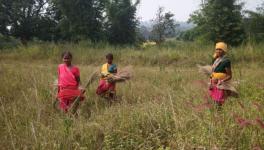3 Wildlife Sanctuaries in Jharkhand Went off Records: Down to Earth

Image for representational use only.Image Courtesy : YouTube
Tribals in the state of Jharkhand have been waging a long battle to stop the mining activity in the mineral-rich state as it adversely affects their environment and livelihood. The tribals, however, claim that consecutive state governments have chosen to support corporate interests over the years.
According to information accessed by Down to Earth, in the past 40 years, the state governments have wiped three wildlife sanctuaries off records in the iron ore-rich West Singhbhum district. These include Sasangda-buru in Saranda forest division, Bamiaburu in Kolhan forest division and Songra or Tebo in Porahat division.
The wildlife sanctuaries were commissioned and found mentions in the records of the now defunct Indian Board for Wild Life (IBWL) in November 1965. The report mentions that Bihar (undivided) has the seven protected areas and two national parks and five sanctuaries which include the three mentioned above. The sanctuaries are also featured in the Indian Forest Records: Glossary of terms used in nature conservation and wildlife management, published by the Forest Research Institute (FRI) in 1970. A book, authored by P Venkataramany, says that while Songra sanctuary was created in 1932, the remaining two were created in 1936. But two of the sanctuaries have just vanished from the day the Wildlife Protection Act, 1972, was enacted. None of the government documents published after 1972 mention Bamiaburu and Songra sanctuaries.
Speaking to NewsClick, Virendra Kumar, a local expert, said, “The entire Saranda area was to be made into a wildlife sanctuary to protect the lives of the adivasis and their natural resources. They worship the mountain there and the Sar jungles. Instead, the government aided mining. They made 40 ft wide roads to enable corporations such as Vedanta, Tata and Hindalco.”
Experts point out that acquiring land for mining activity would have been difficult had the government not eliminated the three sanctuaries. While the first mining leases in Saranda were given in the 1950s, the unfettered jump in leases was kept under check because of the court orders later.
On December 4, 2006, the Jharkhand High Court observed that all projects located within 10 km from the boundary of a sanctuary will need permissions from the National Board for Wildlife (which replaced IBWL in 2003) if its ecosensitive zone is not notified under the Environment Protection Act, 1986. However, since details about the sanctuaries are extremely sketchy, mining activity in the area has continued without any checks.
Speaking to NewsClick, Puneet from the Jharkhand Mines Area Coordination Committee (JMACC) said, “For decades, the mining activity has been aided by people across party lines and governments. Our forest rights are being denied in the process and no land titles are being given. This was a clandestine scheme of the government to take sanctuaries off the records to make the process of corporate acquisition much easier for the big players such as Dempo in Manoharpur.”
Alicem who is also associated with JMACC, said, “Processing plants are being built as we protest and suffer, none of this would have happened had the wildlife sanctuaries been recognised.”
Also read: Sonbhadra: Will Discovery of Gold Finally Bring Development?
Get the latest reports & analysis with people's perspective on Protests, movements & deep analytical videos, discussions of the current affairs in your Telegram app. Subscribe to NewsClick's Telegram channel & get Real-Time updates on stories, as they get published on our website.
























